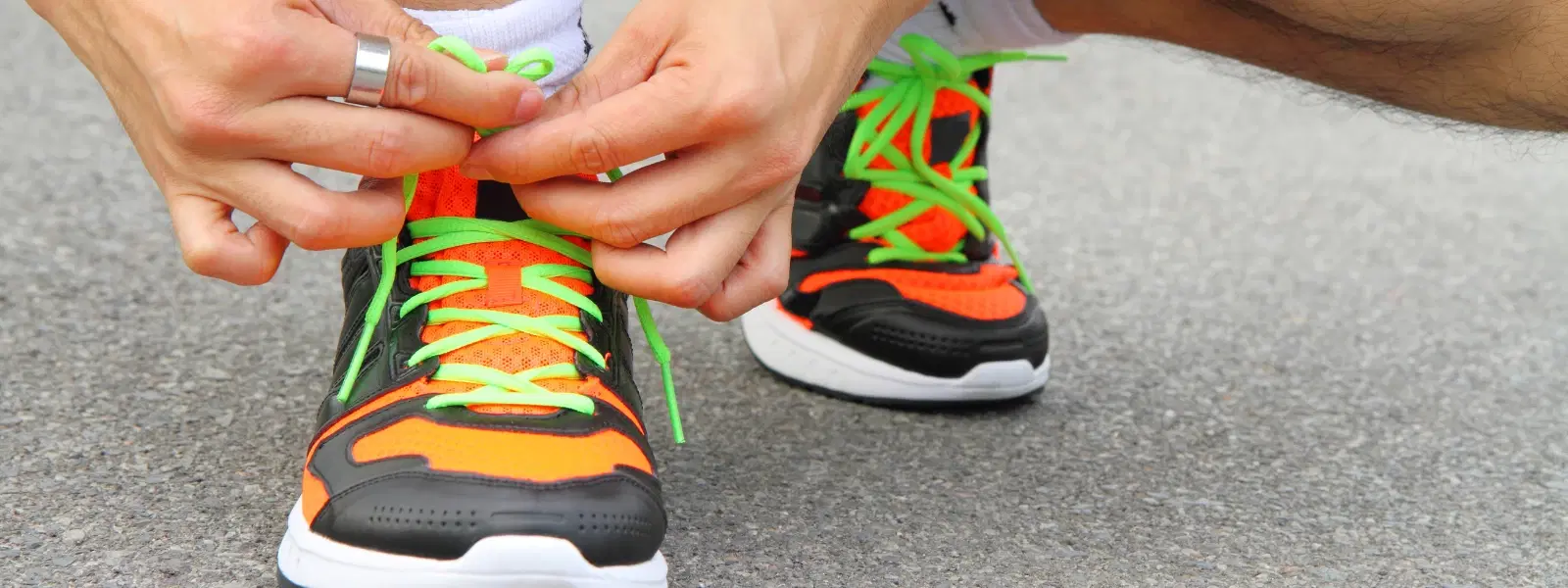
Footwear Guide
•05 min read

Trail running has become a popular way to express your adventurous side while staying active. For those who enjoy challenging terrains and embracing the beauty of nature, choosing the right footwear is essential. These shoes not only empower your performance on rugged terrains but also serve as a bold fashion statement reflecting your unique adventurous spirit. This blog post explains the key differences between trail running shoes and regular shoes. By reading on, you'll learn about their distinct features, understand why each type is important, and discover tips on how to choose the right pair for your outdoor explorations.
Trail running shoes are specially designed for off-road terrains like dirt paths, gravel, rocky surfaces, and muddy trails. The best shoes for trail running are built with features such as rugged outsoles, protective toe caps, and reinforced materials that shield feet from debris. Many models, as noted in industry trends, include enhanced grip for trail running shoes to provide stability on uneven ground. The design of these shoes emphasizes durability and performance, making them a practical choice for those who often explore challenging outdoor environments.
Trail running shoes are ideal for outdoor enthusiasts and runners who seek adventure on rugged terrain. Hikers and nature lovers also benefit from lightweight trail footwear that can withstand the wear and tear of demanding paths. These shoes are indispensable in providing the required support, superior grip, and reliable protection compared to regular athletic shoes. Designed to meet the needs of style-savvy and eco-conscious adventurers, these shoes empower wearers with confidence to tackle terrains that demand more than what traditional running shoes might offer.
Regular shoes, such as casual sneakers or running shoes made for roads, are optimized for smooth, even surfaces like pavements, gym floors, or city tracks. Their lightweight construction and subtle tread patterns make them perfect for everyday activities. While these shoes offer comfort and style for urban settings, they often lack the robust features required for the outdoor challenges posed by trails. Their design focuses more on style and simplicity rather than the technical specifications needed for rugged terrains.
Using regular shoes on trails can be risky. They generally fall short in handling the demands of rocky and uneven surfaces. Without aggressive tread patterns and reinforced structures, regular shoes may not provide the durability required for long runs on rugged terrain. Studies indicate that runners might find these shoes offer limited grip and insufficient protection against debris. When considering durable running shoes for trails, it becomes clear that the material and construction differences are vital for ensuring safety and optimal performance outdoors.
The outsole is one of the most significant differences between trail running shoes and regular shoes. Trail running shoes come with aggressive lug patterns and sticky rubber compounds to ensure excellent traction on slippery or uneven surfaces. This enhanced grip for trail running shoes is a key feature that helps runners maintain stability, even on steep, unpredictable paths. In contrast, regular shoes feature softer outsole designs that are effective only on even and predictable surfaces.

Materials used in trail running shoes are chosen for their strength and durability. Typically, these shoes incorporate waterproof membranes and reinforced uppers that resist abrasions. In addition, the use of robust trail running shoe materials means they can handle harsh terrains while offering excellent protection and longevity. Many models, as noted in industry trends, offer waterproof features, making them a favorable option for those who run in unpredictable weather conditions. Regular shoes, on the other hand, often employ lightweight materials like mesh or synthetic fabrics, which are less suited to extreme outdoor conditions.
Comfort remains a priority in any footwear, but trail running shoes go a step further by incorporating additional cushioning and stability features. Breathable trail running shoes are designed to allow airflow, reducing fatigue even during extended runs. These shoes combine comfort with performance, ensuring that long-distance runners experience both ease and endurance. Regular shoes, while comfortable on smooth surfaces, might not offer the same level of breathability and shock absorption necessary for tackling rugged trails.
Choosing the perfect pair of trail running shoes involves considering several factors. First, assess the typical terrain you will encounter and the weather conditions you may face. Shoes with toe protection, waterproof properties, and sturdy cushioning are crucial for rough trails. When evaluating options, think about how to choose trail running shoes by focusing on grip, proper fit, and durability. Remember, the best shoes for trail running will not only enhance your performance but also protect your feet during those challenging outdoor adventures.
While there are many well-regarded names in the field, select options are renowned for their commitment to innovation and quality in outdoor footwear. They continuously refine trail running shoe features to align with the needs of style-savvy athletes. These leading brands set the benchmark with performance-enhancing materials, exceptional grip, and designs that embody both form and function. Their collections consistently deliver comfortable trail running shoes that meet the demands of modern explorers. With Tata Neu’s exclusive offers, such as earning NeuCoins and accessing curated collections, these brands bring added value to your footwear choices.
A quick comparison can help highlight the differences between the two types of shoes:
Grip and Traction: Trail running shoes have aggressive outsoles with superior traction, while regular shoes are designed for lighter use.
Materials and Durability: Trail shoes use reinforced, waterproof components ideal for harsh terrain, compared to the lighter, less robust materials of regular shoes.
Comfort and Cushioning: Trail shoes incorporate extra cushioning and stability features for long runs, unlike the simpler designs of regular shoes.
Weight: Regular shoes often excel in lightness, but trail shoes balance weight with necessary protection and durability.
Protection Against Debris: Trail running shoes offer enhanced protection with reinforced toe caps which regular shoes generally lack.

If you plan to race along smooth urban paths or gym floors, regular shoes are sufficient. However, if your adventures lead you to muddy, rocky, or unpredictable terrains, investing in trail running shoes is the best decision. They provide enhanced stability, protection, and comfort that can transform your outdoor experience.
Expert Tip: Know Your Terrain Before Choosing Trail Running Shoes
Did you know that the type of terrain you run on significantly impacts your choice of trail running shoes? For rocky paths, opt for shoes with rugged outsoles and reinforced toes. Muddy trails call for waterproof trail running shoes with superior grip.
Trail running shoes are designed for rugged terrains with aggressive tread patterns and reinforced protection, while regular shoes are designed for smooth surfaces and prioritize lightweight comfort.
Trail running shoes are a great option for hiking on technical trails, offering the necessary grip, durability, and comfort for outdoor activities.
Many models offer waterproof options, but not all trail running shoes are waterproof. Look for those with protective membranes if waterproofing is essential.
The shoes typically feature synthetic uppers, reinforced overlays, EVA foam midsoles, and durable rubber outsoles for optimal performance on rugged terrain.
Focus on terrain type, grip, cushioning, waterproofing, and an overall secure fit. Trying on the shoes and reading customer reviews can also aid in making a well-informed decision.
Trail running shoes are engineered to meet the demands of off-road adventures, ensuring that every step on challenging terrain is safe and secure. Their design, featuring enhanced grip, sturdy materials, and superior protection, clearly differentiates them from regular shoes. This guide has provided an in-depth look at the key features and considerations to help you choose the right pair. Embrace the freedom of the outdoors by choosing footwear that supports both performance and your unique style journey. With Tata Neu, you can also enjoy curated collections and earn NeuCoins as part of your trail running experience.